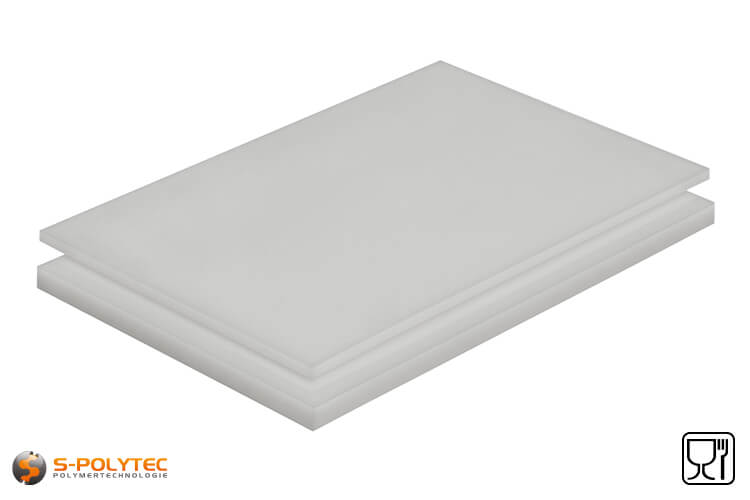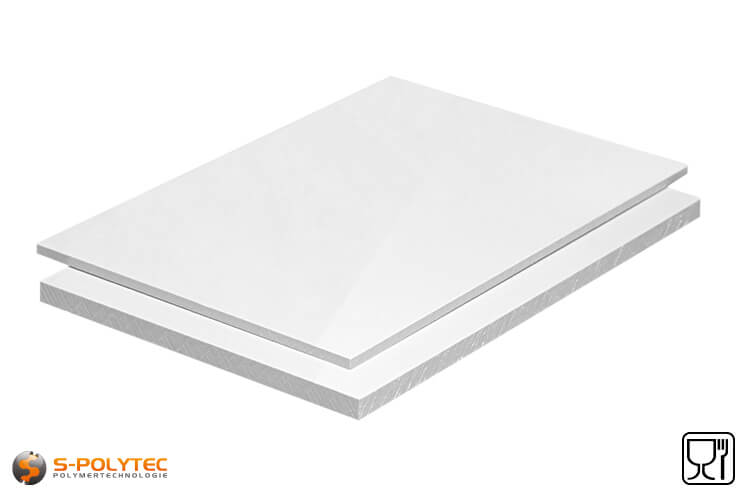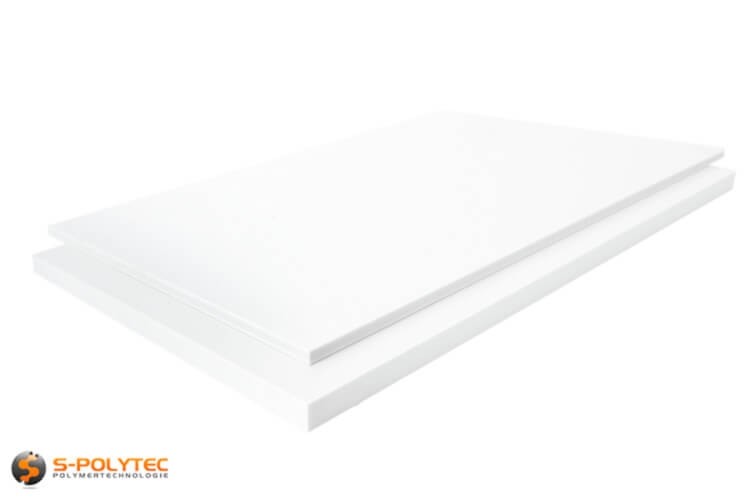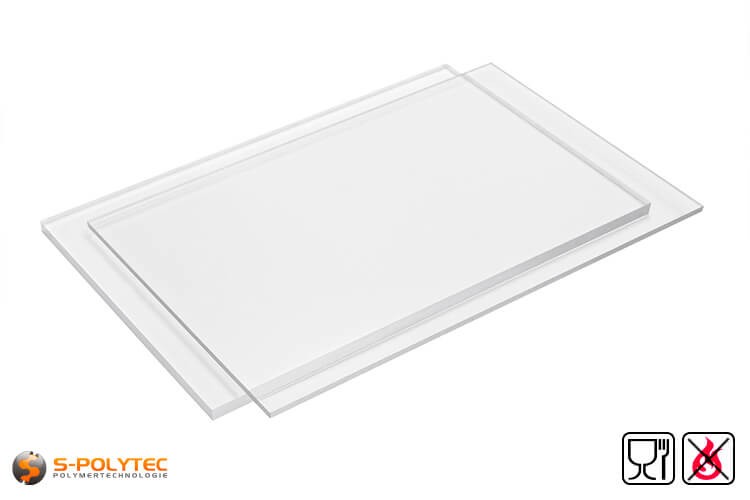
Food-safe plastic sheets at a glance
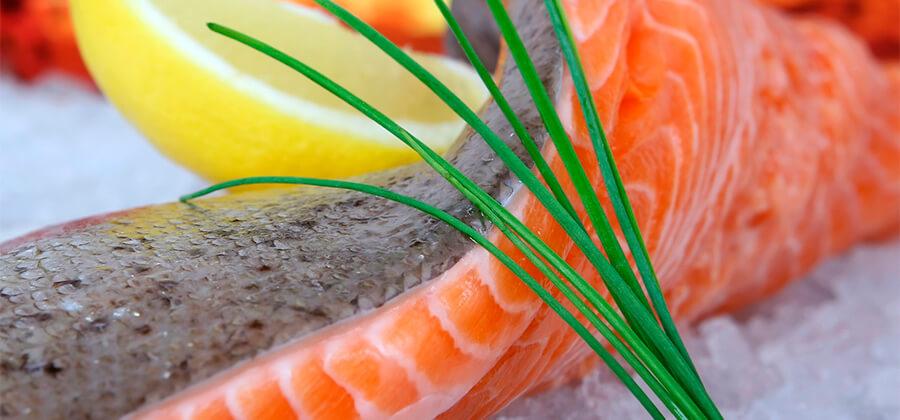
Plastics that are in contact with food must meet high requirements. We explain which plastics meet the requirements and what the differences are between the food-safe plastics.
Plastics are also frequently used in food processing, whether in the food industry, in small food processing companies or in the kitchen at home.
However, not all plastics are suitable for contact with foodstuffs and so care must be taken when selecting the appropriate plastic to ensure that it meets the requirements for food conformity in accordance with the FDA or complies with the EU 10/2011 standard.
Our food-safe plastic sheets at a glance
In our online shop, there is an ever-growing number of different plastic sheets, all of which have different properties. For example, some of our plastics are UV and weather resistant, while others are highly resistant to chemicals or extremely robust and durable. We also have a whole range of plastic sheets which are transparent, the differences between which we have already explained in the previous article.
This week, however, we are talking about the plastic sheets in our online shop that are approved for food and drinking water applications.
When is plastic food safe?
Basically, as soon as a plastic is considered physiologically safe according to BfR and meets the food conformity requirements according to FDA (Food and Drug Administration) or complies with the requirements according to Commission Regulation (EU) No. 10/2011 of 14 January 2011 on plastic materials and articles intended to come into contact with food.
This is also referred to as plastic food contact materials or plastic food contact articles.
Where is food-grade plastic used?
The areas of application for plastics that are approved for contact with food cover a very broad spectrum. From conveyor belts on which food is transported during industrial processing, to table tops on which food is further processed, to industrial packaging of food, plastics are used.
Yet, food-safe plastics are also used in restaurants, bakeries, butchers or supermarkets in, for example, the form of chopping boards, shelves, containers for food, or even packaging material for food.
Plastics with food law approval can also be found in the household. For example, there are plastic breakfast boards or cutting boards in every household, as well as plastic storage boxes, plastic cups and salad bowls. The list could be extended indefinitely, because pretty much all plastic items in the kitchen at home are considered food-safe. Even the inside of a refrigerator is made of plastics that are approved for contact with food.
Polyethylene
Our plastic sheets made of polyethylene all meet the high requirements for food conformity of the EU standard 10/2011 and are considered physiologically harmless according to the BfR, so that all our plastic sheets made of polyethylene are approved for the food and drinking water sector. With the exception of the black polyethylene sheets, all our PE sheets also meet the requirements for food conformity according to FDA.
NOTE:The only exceptions are our electrically conductive plastic sheets made of polyethylene (PE-EL) and the polyethylene sheets made of recycled material, the so-called regenerates (PE-UHMW regenerate or PE-1000 regenerate). However, these are special plastics with other areas of application. These exceptions are not approved for contact with food!
Polyethylene is used in particular for cutting boards and work pads because of its very high impact strength. But also transport rollers and rollers in conveyor technology that are in contact with food are very often made of polyethylene due to the durability of this plastic.
Polyethylene is also highly resistant to chemicals and thus also to corresponding ingredients such as strong vinegar, oils or wine. The repellent surface is particularly useful in the production of fresh food boxes or plastic bowls.
The application temperatures range from -50°C for conventional high-density polyethylene to enormous lowest temperatures of -260°C for our plastic sheets made of PE-UHMW (PE-1000). The upper limit of the application temperature range is +80°C. This means that polyethylene can withstand even months of storage in a freezer.
Compared to other plastics, polyethylene has the disadvantage that it is very sensitive to scratching. The comparatively soft surface of polyethylene also has advantages, however, because it protects the sensitive blade of knives from dulling, especially on chopping boards.
- Polyethylene has excellent chemical resistance
- Polyethylene has very good impact resistance
- Polyethylene has very good resistance to low temperatures
- Polyethylene can be used at temperatures from -260° to +80°C
- Polyethylene is dishwasher and microwave safe
- Polyethylene is relatively sensitive to scratching
- Polyethylene is not flame retardant
Polypropylene
Polypropylene has comparable properties to polyethylene, but there are a few notable differences. Like our polyethylene sheets, our polypropylene sheets are all approved for food contact and are considered physiologically safe. The requirements for food conformity according to FDA are fulfilled by all PP-H sheets. The requirements according to EU 10/2011 are also fulfilled by all except the PP-C plastic sheets, so all our polypropylene sheets may be used for food and drinking water applications.
NOTE:However, there are two exceptions that are not approved for contact with food. These are polypropylene sheets in special designs that were developed for special applications, such as the flame-retardant PP-S sheets or the electrically conductive PP-EL-S sheets.
Polypropylene is very resistant to chemicals such as many acids, alkalis and solvents and can therefore withstand almost all ingredients from the food sector. For this reason, fresh food containers and crockery for camping are often made of polypropylene.
Polypropylene is a permanently heat-stable plastic that can be used permanently even at higher temperatures of up to +110°C (even up to 140°C is possible for short periods). However, polypropylene is not frost-resistant and should therefore not be used at temperatures below 0°C. The good resistance to higher temperatures is used in particular in the production of kitchen aids or microwave dishes made of plastic.
Polypropylene also has a fairly good surface hardness, which is why prefabricated plastic parts made of polypropylene do not scratch too quickly compared to polyethylene.
- Polypropylene has excellent chemical resistance
- Polypropylene has very good impact strength
- Polypropylene is permanently heat-stable even at high temperatures
- Polypropylene is dishwasher and microwave safe
- Polypropylene can be used at temperatures from 0°C to +110°C
- Polypropylene is relatively insensitive to scratches
- Polypropylene is not frost-resistant
- Polypropylene is not flame retardant
Polytetraflourethylene
Polytetraflourethylene, hereafter abbreviated as PTFE (otherwise the text here would be too long), is also very often referred to simply by the brand name Teflon. PTFE is a high-performance plastic that is characterised in particular by its enormous temperature resistance.
PTFE sheets can be used permanently at very low and very high temperatures from -200°C to +260°C
In addition, PTFE has outstanding sliding properties and extremely high chemical resistance.
PTFE is a comparatively expensive high-performance plastic that is rather not encountered in the domestic kitchen, except perhaps as non-stick coatings in pans or the like. Therefore, plastic sheets made of PFTE, although approved for contact with food, are primarily used in industrial plants because of their enormous sliding properties. The chemical industry, on the other hand, makes use of both the high temperature resistance and the enormous chemical resistance.
- PTFE has outstanding chemical resistance
- PTFE exhibits tremendous sliding properties
- PTFE can withstand extreme temperatures permanently
- PTFE can be used at temperatures from -200° to +260°C
- PTFE is a relatively expensive plastic
- PTFE is comparatively sensitive to scratches
PETG
Plastic sheeting made of is a polyethylene terephthalate modified with glycol and is the only plastic we carry in our online shop that is considered flame retardant according to the fire protection standard DIN 4102 B1 (applies to thicknesses of 1mm-8mm).
In addition, PETG is the only plastic available in our standard product range with approval for the food sector that is both transparent and has a high light transmission.
PETG is considered to be an extremely resistant plastic that can be used at temperatures as low as -40°C. Even at such temperatures, our PETG sheets are impact and break resistant and are therefore ideally suited for the production of refrigerated counters in food markets or butcher's shops. The material is also very suitable in the catering industry, for example, when it comes to viewing windows in refrigerators.
However, PETG is not particularly resistant in the upper temperature range and can only be used at temperatures of up to +65°C.
- PETG meets the fire protection standard DIN 4102 B1 (flame retardant) in thicknesses of 1mm-8mm
- PETG has very good chemical resistance
- PETG is frost-resistant and can be used from -40°C
- PETG is transparent and translucent
- PETG is considered very impact resistant and shatterproof .
- PETG can be used at temperatures up to +65°C only
- PETG is not microwaveable
